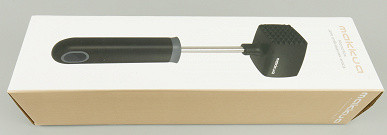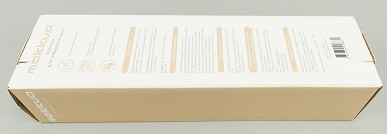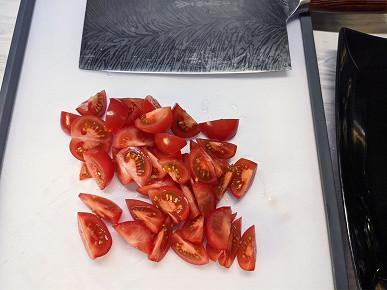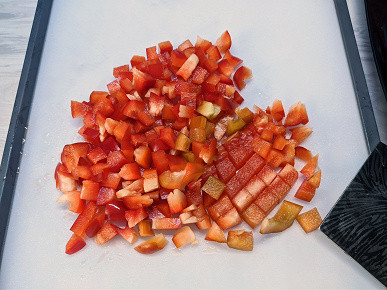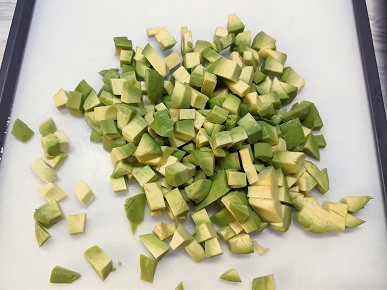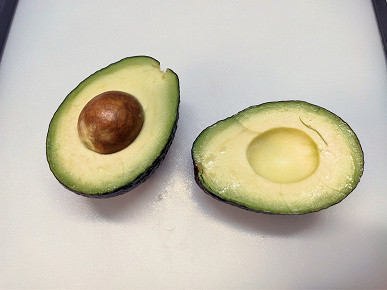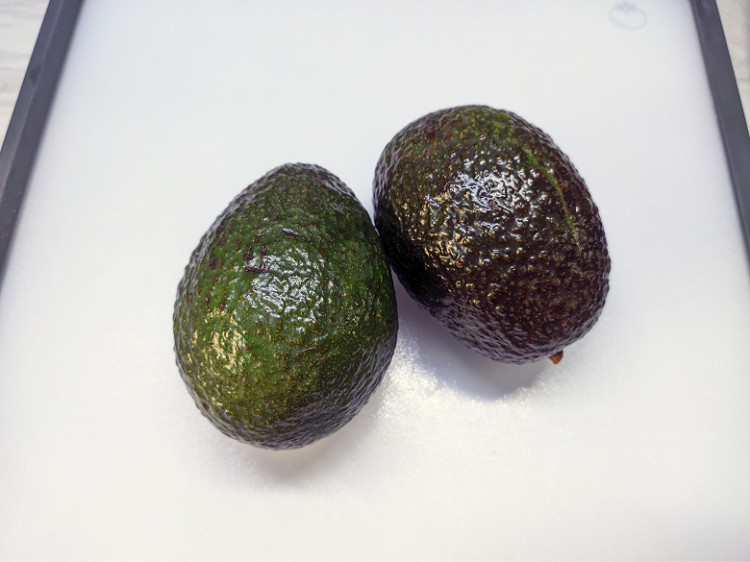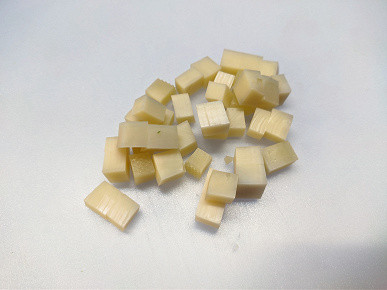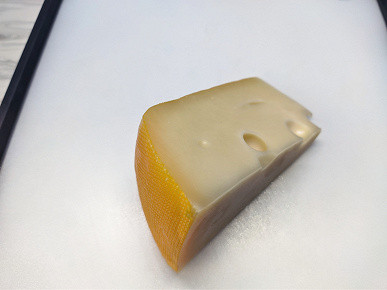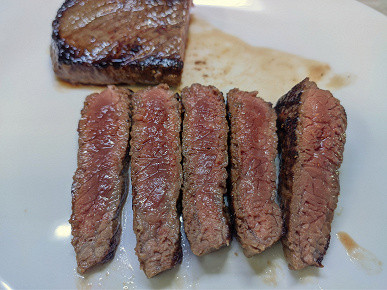We specialize in home appliances, including kitchen appliances, but occasionally come across conventional, non-electronic gadgets that make cooking easier. We are happy to test them and share our impressions. Today we have three interesting items that are worth checking out: a double-sided cutting board (metal and plastic), a meat hammer and a meat tenderizer, all under the Makkua brand.
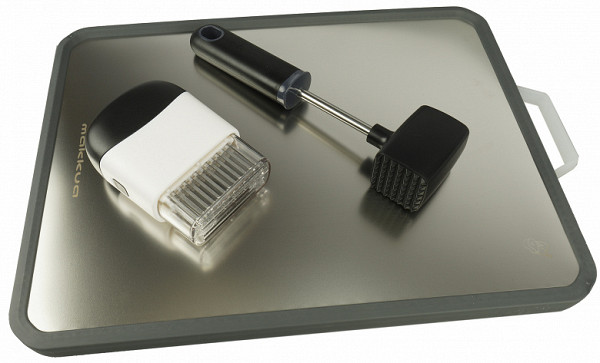
We examined the new products with interest and, without delaying the matter, decided to test them in action. And, of course, share my impressions with you.
Characteristics
Cutting board
| Manufacturer | Makkua |
|---|---|
| Model | Cutting Board |
| Type | cutting board |
| Country of Origin | China |
| Material | stainless steel, plastic |
| Weight | 1.58 kg |
| Dimensions (W×H×D) | 390×290×22 mm |
Meat hammer
| Manufacturer | Makkua |
|---|---|
| Model | MK002 |
| Type | meat hammer |
| Country of Origin | China |
| Material | stainless steel, wear-resistant ABS plastic |
| Weight | 415 g |
| Dimensions (W×H×D) | 245×686×508 mm |
Meat tenderizer
| Manufacturer | Makkua |
|---|---|
| Model | MK001 |
| Type | tenderizer (meat tenderizer) |
| Country of Origin | China |
| Material | stainless steel, plastic |
| Weight | 222 g |
| Dimensions (W×H×D) | 85×115×40 mm |
Equipment
All accessories are supplied in light-colored cardboard boxes with excellent printing quality. The front side of the packaging contains full-color photographs of the devices, and their main characteristics are indicated on the sides and back.

It is no secret that such accessories are often purchased as gifts, so the appearance of the packaging is of great importance.
This is what a box with a cutting board looks like...

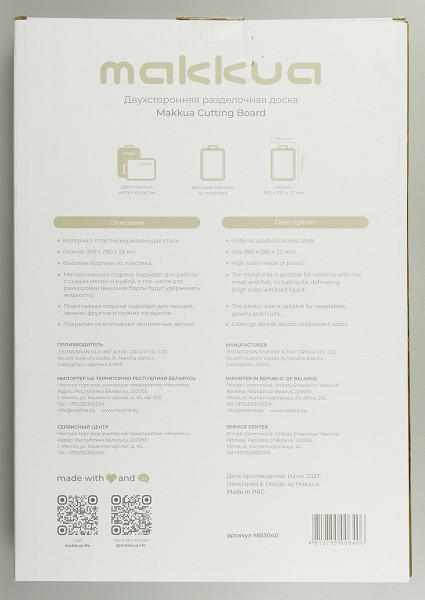
Like this — with a meat hammer...
And like this — with a tenderizer.
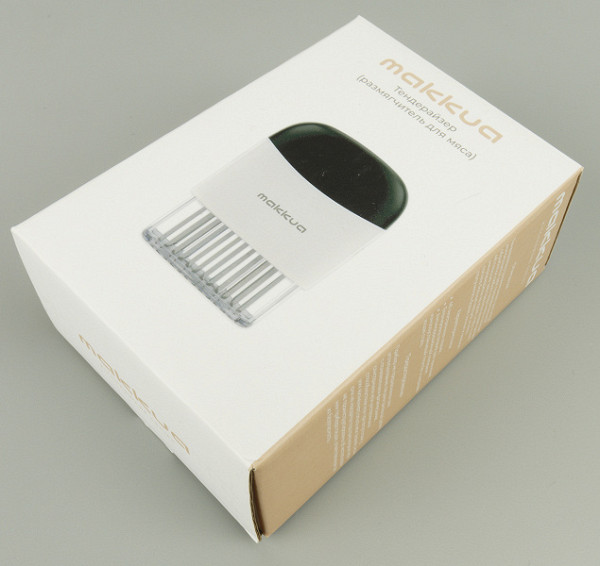
The contents were packed in plastic bags. There were no instructions or printed materials inside, although they might have been useful for the tenderizer.
At first sight
Let's take a closer look at all the accessories and note their characteristic features.

Let's start with the cutting board. It is reversible and has a plastic handle on top, allowing you to hang it on a kitchen hook or simply carry it. Considering the considerable weight of the board, this feature is very convenient.
One side (for meat) is made of stainless steel.
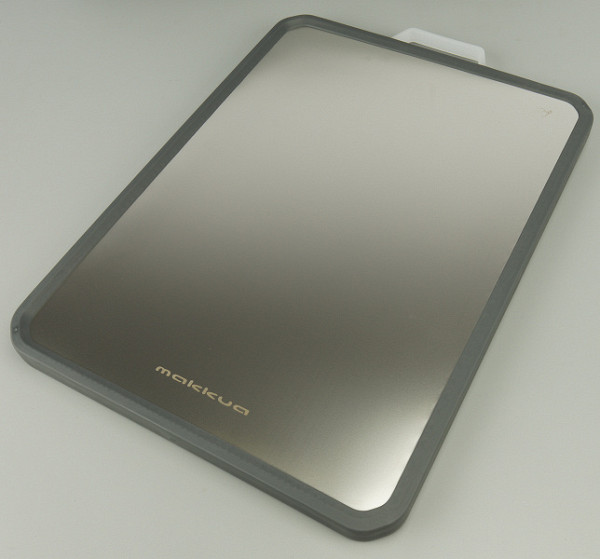
At the bottom we see the Makkua logo.
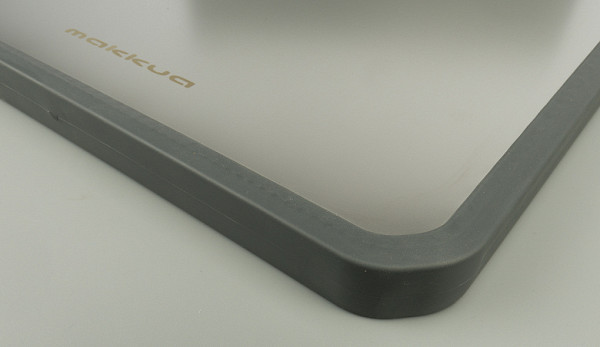
In the upper right corner there is a pictogram depicting a chicken leg and a piece of meat. Everything is simple, clear and visual.

The second side, intended for vegetables and fruits, is plastic.
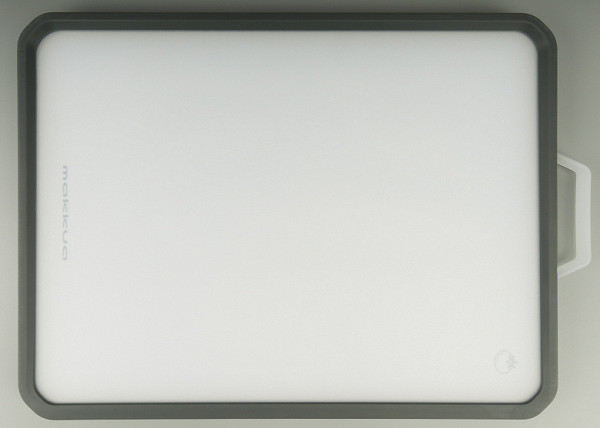
The surface is matte, slightly rough. The design is the same: logo at the bottom...
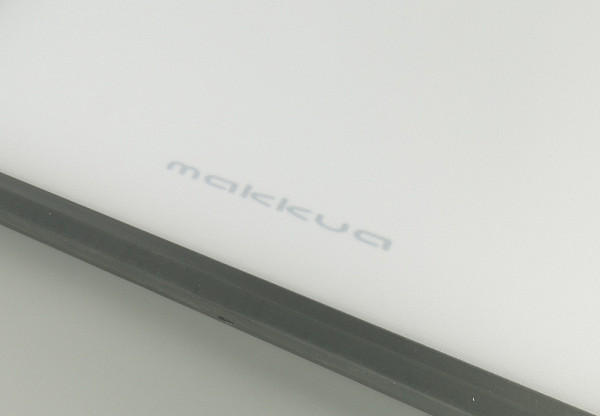
...and an icon with a tomato in the upper right corner.
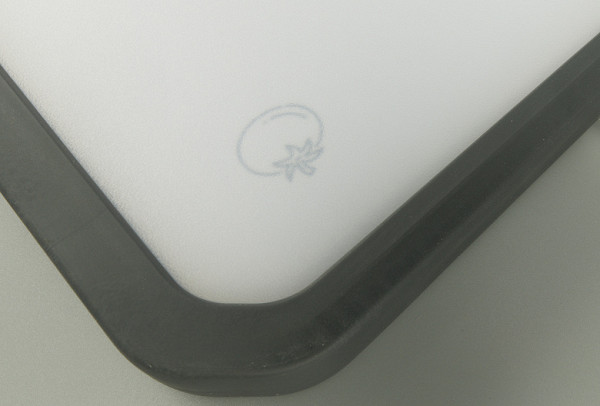
In conclusion, we note the massive plastic frame, slightly protruding above the surface of the board. Why it is needed and how convenient such a solution will be will be discussed a little later. Now let's move on to the hammer.

Here, in general, everything is simple. Our hammer has a rubberized handle, which has a hole with a plastic insert through which the hammer can be hung on a hook.
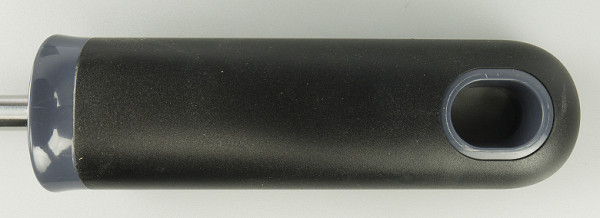
The handle and head of the hammer are made of stainless steel. The head is painted black.
The firing pin is flat on one side...
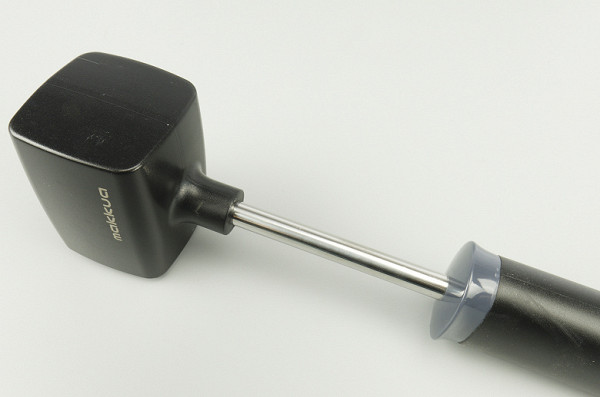
And on the other hand, with small teeth.
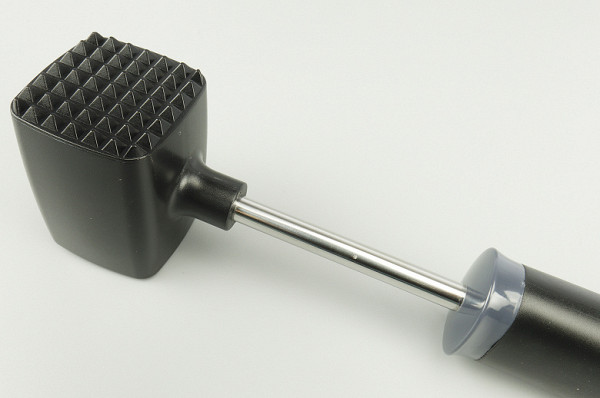
The manufacturer's logo is printed on the side of the head.
The most high-tech device in our set is the tenderizer.

The compact device is made of white and black matte plastic.

28 flat, sharpened stainless steel blades are arranged in four rows and covered with a transparent plastic cover.
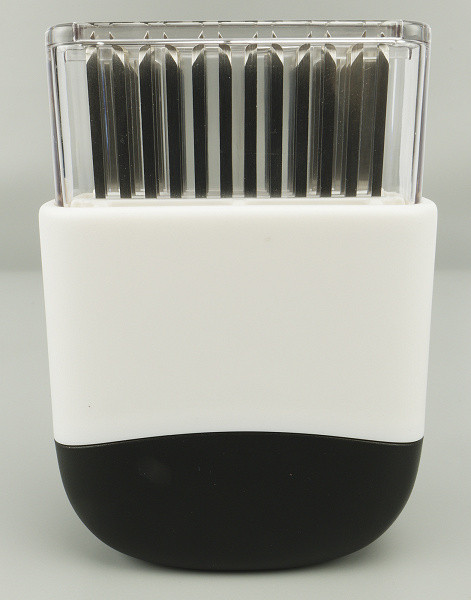
There is no need to remove the cover to operate: when pressed, the knives will automatically extend through special slots.

On the sides of the tenderizer there are plastic snap buttons, by pressing which the device can be disassembled.
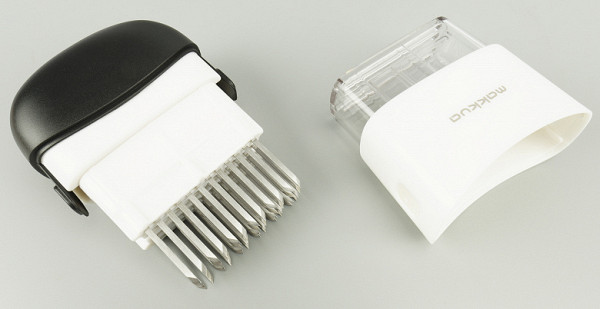
This way you can access the knives for cleaning.
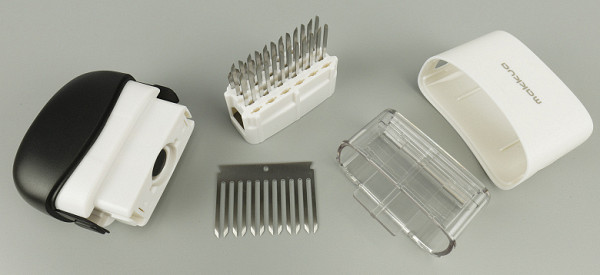
The knives themselves are sharp, so you need to use the device carefully. Do not give to children.
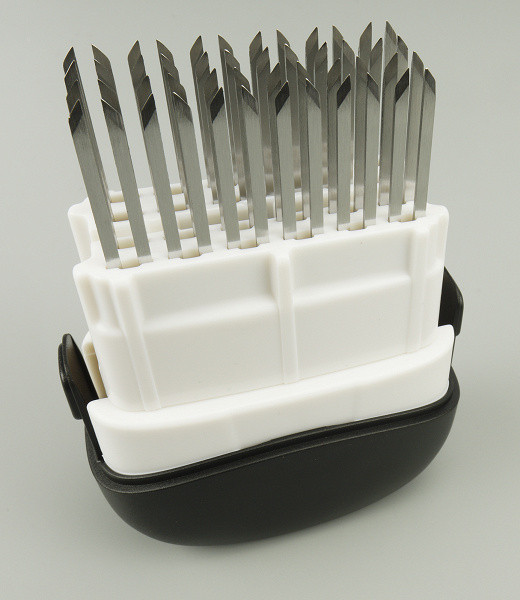

Finally, the tenderizer has a twist latch on top that allows you to lock the device to prevent accidental injury.
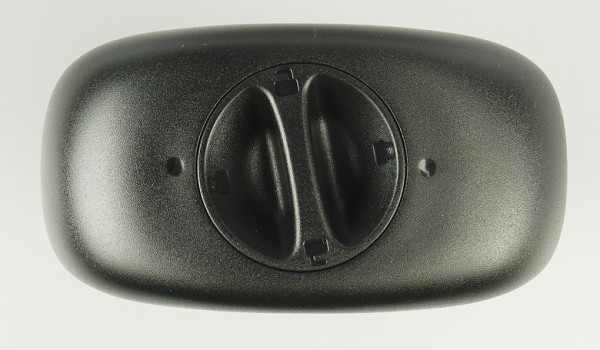
To summarize the external inspection: all accessories look strong. They are made of high-quality materials, they are pleasant to hold in your hands and look at in the interior of the kitchen.
Exploitation
The most interesting thing is to understand how convenient our devices are in real use. We tested them and are ready to share our impressions.
Let's start with the cutting board. We admit, the prospect of cutting meat on a metal sheet seemed strange at first. We thought that the knives would quickly become dull and the steel would quickly become scratched. This was partially confirmed: we didn’t like the sensation of a knife scratching on metal, but the knives didn’t dull as quickly as we expected. We tried to reduce the pressure when contacting a metal surface, and as a result the knife became dull about the same as when using a wooden board.
The plastic side of the board did not surprise us. High-quality plastic that does not bend when pressed turned out to be very convenient for cutting vegetables and fruits.
Let's talk about the plastic side. This solution has its pros and cons. On the one hand, the edge keeps all the juices and liquids on the board, which makes it easier to clean and prevents the tabletop from getting dirty. It is enough to rinse the board under running water or wipe it with a napkin to continue working. In addition, the chopped products remain on the board and do not fall on the table. An unobvious advantage is that the board can be used to defrost small portions of meat.
Another advantage of the board is its resistance to corrosion and odors, both on metal and plastic surfaces. You can clean the board with plain water.
Disadvantages include difficulty in brushing cut-up foods into dishes due to the side. You will have to transfer them manually or on the plane of a knife. There is also a risk of cutting the edge of the rim with a knife when cutting at an angle or when trying to collect food with a horizontal knife. Scratches on the metal side appear quite quickly and are noticeable.
The meat hammer turned out to be simple and convenient. Its work surface does not absorb odors and the hammer is easy to clean, including being dishwasher safe. The noise when beating meat is minimal, and the process itself is quick and easy, without much effort.
Now about the tenderizer. It’s simple to use: place the tenderizer on a piece of meat with the knives down and press on the top. The knives extend, pierce the meat and retract. The official website states that you need to remove the protective cover, but in fact there is none — instead, a transparent cover with slots is used. There is a twist latch on the top of the tenderizer that locks the device, preventing the blades from being accidentally pulled out and ensuring safety.
It takes no more than a minute to prepare one piece of meat with a tenderizer.
Care
Caring for all devices is quite simple. Wash them under running water with a mild detergent, then dry thoroughly. There are no rusting elements here, but it is not recommended to leave the devices in the sink for a long time or soak them.
Wash everything immediately after use, especially the tenderizer, as dried meat juices are difficult to clean off the knives. The tenderizer body should not be immersed in water: there is a spring inside that may be damaged. Only immerse the knives in water and wipe the body with a damp cloth.
The hammer can be washed in the dishwasher, but we recommend not to overuse it.
Practice tests
Finally, let's test our devices in action. We will cut, beat and pierce everything we have at hand. There will be few comments here. Mainly photographs.
Cutting board
We start from the metal side. We arm ourselves with a knife and a large piece of meat and cut it.
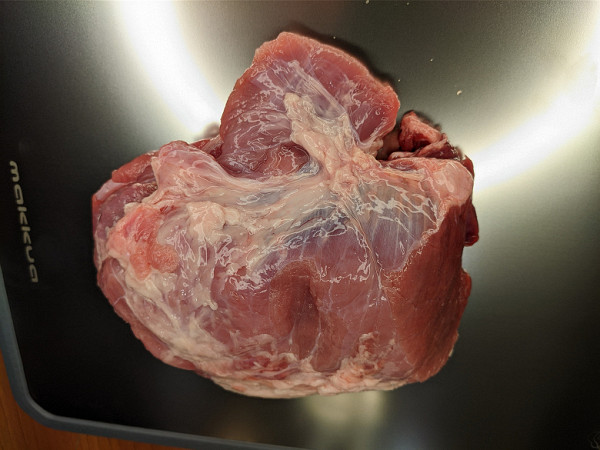
We note that the process is quick and easy. Everything is convenient. First, cut the meat into large pieces.
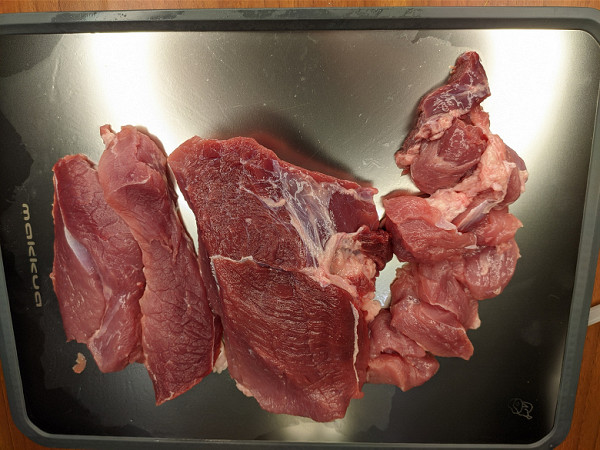
Then into small ones (we plan to put it through a meat grinder).

Next we move on to the plastic side. Let's try to make a Cobb salad. Here we will need to chop quite a lot of ingredients — vegetables, cheese, cooked chicken and even avocado.
Again everything goes easily and quickly.
After cutting the vegetables, wipe the board with a paper towel to remove excess juice and move on to the next product.
After the cheese, the board had to be rinsed.
Place the chopped ingredients on a plate. Add lettuce and other greens, as well as chicken, bacon and anything you like (like corn or blue cheese). Separately prepare the dressing by whisking mustard with vegetable oil. Salad ready.
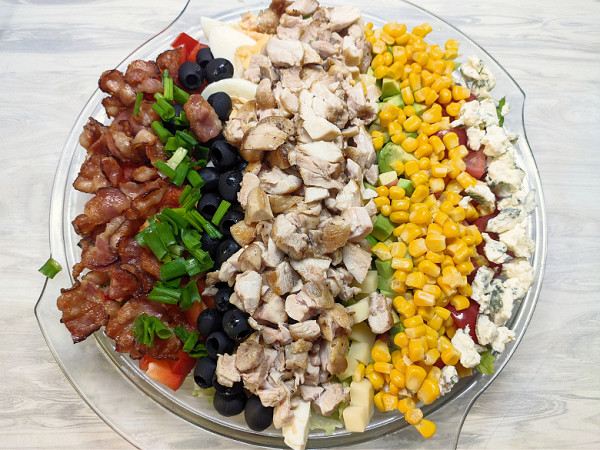
Meat hammer
We will test the hammer on pork that has been pre-cut into suitable pieces.
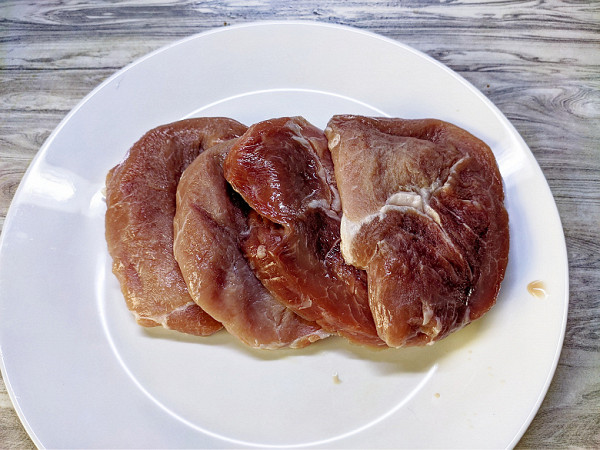
We take a couple of pieces and literally in a couple of minutes turn them into flat, beaten schnitzels.
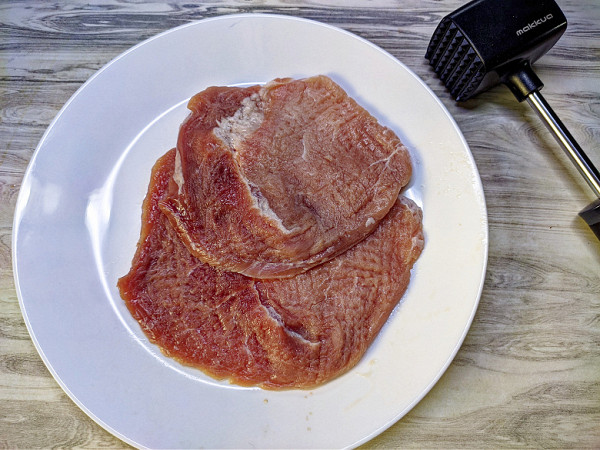
We note that a hammer does its job perfectly: if you overdo it, you can make the meat thinner than you would like. Therefore, we beat it carefully, without putting too much effort.
Tenderizer
We test the tenderizer on the same pork.
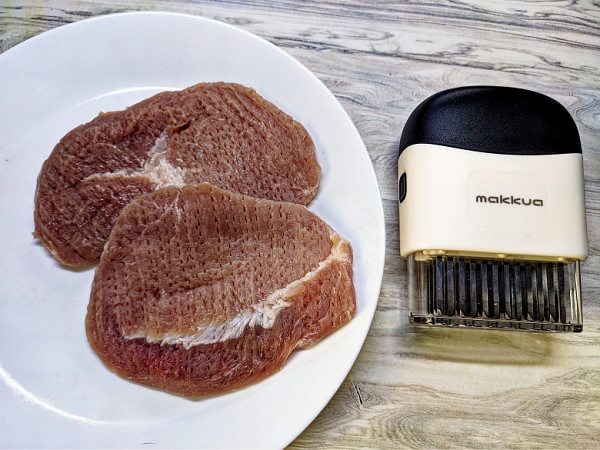
Two pieces of meat were pierced with knives in less than two minutes. Excellent result.
Roll the prepared meat first in flour, then in a lightly beaten egg and finally in breadcrumbs. Quickly fry in a frying pan.
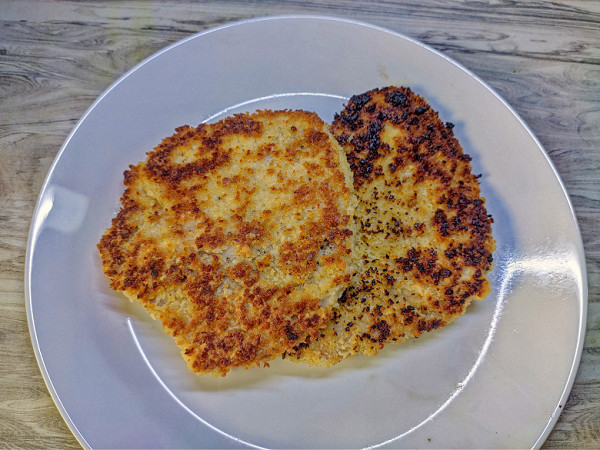
We get an ideal result (on the left) and a less ideal result if we make a slight mistake (on the right).
For the second test of cooking beef rump steak, we cut the meat into pieces of the appropriate size and thickness.
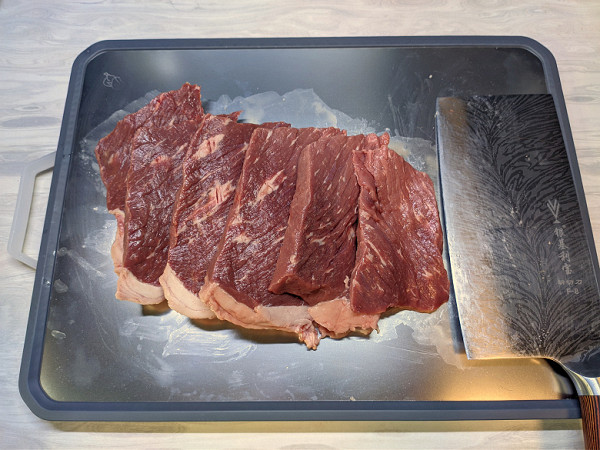
Treated with tenderizer.
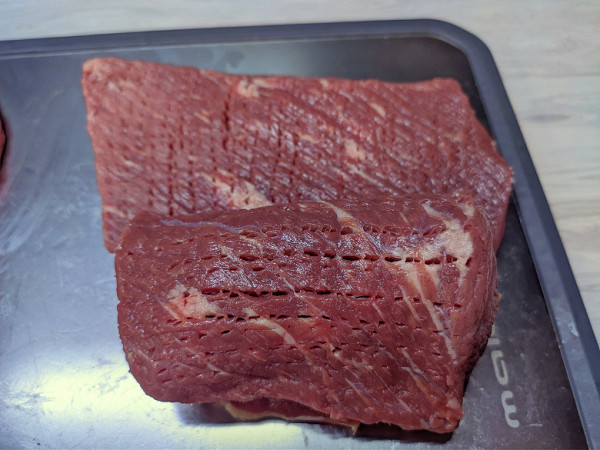
And some were recaptured for the sake of experimentation.


The prepared pieces were salted, peppered and fried in a heated frying pan.
Then the taste and degree of roasting were assessed.
We evaluate the experiment as very positive with regard to the operation of the tenderizer. But the chopped pieces of meat turned out to be not so tasty. Therefore, if we are going to cook steaks or something similar, we will use a tenderizer.
conclusions
In short, Makkua kitchen accessories left us with a positive impression. They were easy and pleasant to use, they were of high quality and attractive. The tactile sensations are pleasant, they are easy to clean and easy to store. The packaging is also commendable, making them a great gift.
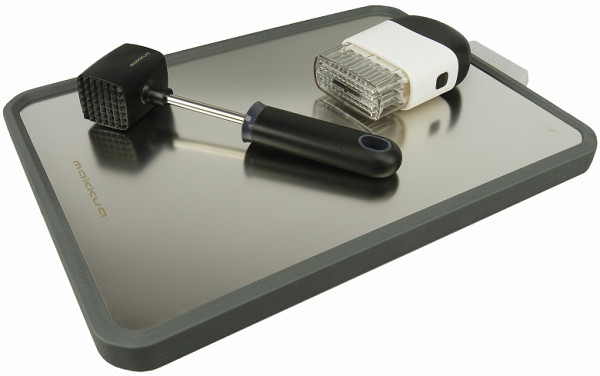
During testing, we were unable to find any flaws. However, we had some personal questions about the cutting board: the metal cutting surface and plastic raised frame are not exactly a standard solution. This may be especially unusual for those who have previously only used regular wooden or plastic cutting boards without frames or other improvements.
Pros:
- nice packaging
- high-quality and tactilely pleasant materials
- easy to clean and store
Minuses:
- rapid appearance of scratches on the surface of the board

